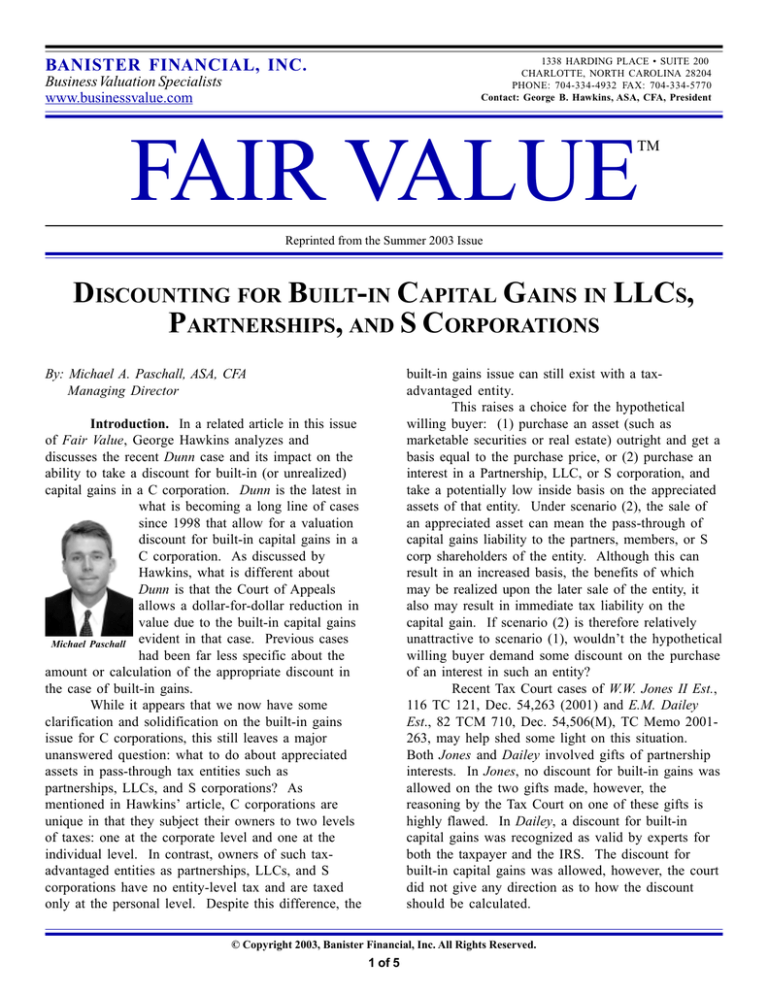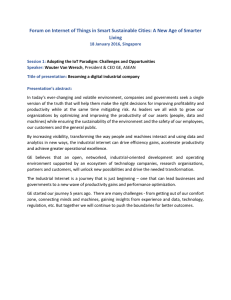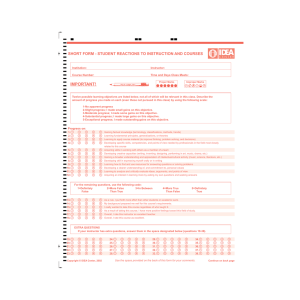
1338 HARDING PLACE • SUITE 200
CHARLOTTE, NORTH CAROLINA 28204
PHONE: 704-334-4932 FAX: 704-334-5770
Contact: George B. Hawkins, ASA, CFA, President
BANISTER FINANCIAL, INC.
Business Valuation Specialists
www.businessvalue.com
FAIR VALUE
TM
Reprinted from the Summer 2003 Issue
DISCOUNTING FOR BUILT-IN CAPITAL GAINS IN LLCS,
PARTNERSHIPS, AND S CORPORATIONS
built-in gains issue can still exist with a taxadvantaged entity.
This raises a choice for the hypothetical
willing buyer: (1) purchase an asset (such as
marketable securities or real estate) outright and get a
basis equal to the purchase price, or (2) purchase an
interest in a Partnership, LLC, or S corporation, and
take a potentially low inside basis on the appreciated
assets of that entity. Under scenario (2), the sale of
an appreciated asset can mean the pass-through of
capital gains liability to the partners, members, or S
corp shareholders of the entity. Although this can
result in an increased basis, the benefits of which
may be realized upon the later sale of the entity, it
also may result in immediate tax liability on the
capital gain. If scenario (2) is therefore relatively
unattractive to scenario (1), wouldn’t the hypothetical
willing buyer demand some discount on the purchase
of an interest in such an entity?
Recent Tax Court cases of W.W. Jones II Est.,
116 TC 121, Dec. 54,263 (2001) and E.M. Dailey
Est., 82 TCM 710, Dec. 54,506(M), TC Memo 2001­
263, may help shed some light on this situation.
Both Jones and Dailey involved gifts of partnership
interests. In Jones, no discount for built-in gains was
allowed on the two gifts made, however, the
reasoning by the Tax Court on one of these gifts is
highly flawed. In Dailey, a discount for built-in
capital gains was recognized as valid by experts for
both the taxpayer and the IRS. The discount for
built-in capital gains was allowed, however, the court
did not give any direction as to how the discount
should be calculated.
By: Michael A. Paschall, ASA, CFA
Managing Director
Introduction. In a related article in this issue
of Fair Value, George Hawkins analyzes and
discusses the recent Dunn case and its impact on the
ability to take a discount for built-in (or unrealized)
capital gains in a C corporation. Dunn is the latest in
what is becoming a long line of cases
since 1998 that allow for a valuation
discount for built-in capital gains in a
C corporation. As discussed by
Hawkins, what is different about
Dunn is that the Court of Appeals
allows a dollar-for-dollar reduction in
value due to the built-in capital gains
Michael Paschall evident in that case. Previous cases
had been far less specific about the
amount or calculation of the appropriate discount in
the case of built-in gains.
While it appears that we now have some
clarification and solidification on the built-in gains
issue for C corporations, this still leaves a major
unanswered question: what to do about appreciated
assets in pass-through tax entities such as
partnerships, LLCs, and S corporations? As
mentioned in Hawkins’ article, C corporations are
unique in that they subject their owners to two levels
of taxes: one at the corporate level and one at the
individual level. In contrast, owners of such taxadvantaged entities as partnerships, LLCs, and S
corporations have no entity-level tax and are taxed
only at the personal level. Despite this difference, the
© Copyright 2003, Banister Financial, Inc. All Rights Reserved.
1 of 5
CAPITAL GAINS (continued)
Keeping up with the Joneses. We will first
look at the Jones case. In Jones, the decedent had
one son and four daughters. The decedent formed
family partnership A with his son as each party
contributed assets (primarily a cattle ranch) to the
partnership. The son was the sole general partner
and the decedent was a limited partner. The decedent
then transferred an 83.03% limited partnership
interest to his son.
The decedent also formed family partnership
B with his four daughters as each person contributed
assets (primarily another cattle ranch) to the
partnership. Two of the daughters were general
partners. The decedent and the other two daughters
were limited partners. The decedent then transferred
16.915% limited partnership interests to each of his
four daughters (or 67.66% total).
The tax court held that both partnerships were
properly formed and there was no taxable gift by the
decedent to his children upon the formation of the
partnerships. The tax court also held that the interests
transferred were actual limited partnership interests
and not assignee interests.
There were significant built-in gains at both
partnerships. At the time the decedent made his
transfers, Partnership A had a net asset value of $11.6
million and a basis of about $500,000, or a built-in
capital gain of about $11.1 million. Likewise,
Partnership B had a net asset value of $7.7 million
and a basis of $1.8 million, or a built-in capital gain
of about $5.9 million.
The Discount Battle. The decedent's estate
employed an independent business appraiser to
determine the appropriate discounts for federal gift
tax purposes. This appraiser applied discounts for
lack of control, lack of marketability, and built-in
gains. This appraiser took a 66% discount for the
partnership A gift and a 58% discount for the
partnership B gifts. Not surprisingly, the appraiser
for the IRS opined that no discount was appropriate
on either gift.
In first addressing Partnership A, the Tax
Court allowed only an 8% discount for lack of
marketability on the gift of the 83.03% interest. A
key reason for the Tax Court’s decision in this matter
was the fact that the partnership agreement for
Partnership A required a 75% limited partnership vote
to remove the general partner or liquidate the
partnership. Consequently, the buyer of an 83.03%
interest could immediately remove the general
partner, install himself as general partner, and
liquidate the partnership. The Tax Court’s analysis of
Partnership B was different. Because the gifted
interests in Partnership B were true minority interests,
the Tax Court allowed a 40% discount for lack of
control and 8% discount for lack of marketability on
the gifts of the 16.915% interests.
The Section 754 Election. Both parties
agreed that the tax on the built-in gains could be
avoided by use of a section 754 election. The Court
noted as follows:
“The parties and the experts agree that tax on
the built-in gains could be avoided by a
section 754 election in effect at the time of
sale of partnership assets. If such an election
is in effect, and the property is sold, the basis
of the partnership’s assets (the inside basis) is
raised to match the cost basis of the transferee
in the transferred partnership interest (the
outside basis) for the benefit of the transferee.
See sec. 743(b). Otherwise, a hypothetical
buyer who forces a liquidation could be
subject to capital gains tax on the buyer’s
pro-rata share of the amount realized on the
sale of the underlying assets of the
partnership over the buyer’s pro-rata share of
the partnership’s adjusted basis in the
underlying assets. See sec. 1001. Because
the [Partnership A] agreement does not give
the limited partners the ability to effect a
section 754 election, in this case the election
would have to be made by the general
partner.”
The Built-in Gains Issue: Partnership A.
The taxpayer’s expert argued that a discount for
built-in gains was appropriate for the Partnership A
gift. Although the taxpayer’s expert acknowledged
that there was a 75% to 80% chance that the 754
election would be made and that the election would
not create any adverse consequences or burdens on
Partnership A, this expert nonetheless believed that a
discount for built-in gains was appropriate due to the
fact that the decedent’s son (the sole general partner
of Partnership A) stated that he might refuse to
cooperate with an unrelated buyer of the 83.03%
interest. The Tax Court rejected the opinion of the
taxpayer’s expert as an “attempt to bootstrap the facts
to justify a discount that is not reasonable under the
circumstances.”
2 of 5
CAPITAL GAINS (continued)
The expert for the IRS argued that no
discount for built-in gains was warranted for
Partnership A. The expert for the IRS argued that:
primarily on the assumption that a 754 election
would not cause a significant burden on Partnership
B:
“a hypothetical willing seller of the 83.03%
interest would not accept a price based on a
reduction for built-in capital gains. The
owner of that interest has effective control, as
discussed above, and would influence the
general partner to make a section 754
election, eliminating any gains for the
purchaser and getting the highest price for the
seller. Such an election would have no
material or adverse impact on the preexisting
partners.”
“For the reasons set forth in the built-in
capital gains analysis for [Partnership A], an
additional discount for lack of marketability
due to built-in gains in [Partnership B] is not
justified. Although the owner of the
percentage interests to be valued with respect
to [Partnership B] would not exercise
effective control, there is no reason why a
section 754 election would not be made.
[The taxpayer’s expert] admits that, because
[Partnership B] has relatively few assets, a
section 754 election would not cause any
detriment or hardship to the partnership or the
other partners. Thus, we agree with the
[expert for the IRS] that the hypothetical
seller and buyer would negotiate with the
understanding that an election would be
made. [The] assumption [by the taxpayer’s
expert] that [the general partners of
Partnership B] might refuse to cooperate with
a third-party purchaser is disregarded as an
attempt to bootstrap the facts to justify a
discount that is reasonable under the
circumstances. Therefore, a further discount
for built-in capital gains is not appropriate in
this case.”
The Tax Court rejected the reliance on the
Davis and Eisenberg cases by the taxpayer’s expert.
Davis and Eisenberg were earlier cases where the Tax
Court allowed a discount for built-in capital gains due
to appreciated assets held in a C corporation. In
rejecting the taxpayer’s reliance on Davis and
Eisenberg, the Tax Court noted the following:
“In the cases in which the discount was
allowed [namely, Davis and Eisenberg], there
was no readily available means by which the
tax on built-in gains would be avoided. By
contrast, disregarding the bootstrapping
testimony by [the decedent’s son] in this case,
the only situation identified in the record
where a section 754 election should not be
made by a partnership is an example by [the
taxpayer’s expert] of a publicly syndicated
partnership with ‘lots of partners…and a lot
of assets’ where the administrative burden
would be great if an election were made. We
do not believe that this scenario has
application to the facts regarding the
partnerships in issue in this case. We are
persuaded that, in this case, the buyer and
seller of the partnership interest would
negotiate with the understanding that an
election would be made and the price agreed
upon would not reflect a discount for built-in
gains.”
Where do we go from here? In trying to
read between the lines to apply the rationale of this
case in future situations, it appears the Tax Court
placed weight on the following issues as concerns the
ability to take a discount for built-in gains in a
partnership scenario:
1. Influence that the transferred interest
has over the ability to make the 754 election. This
is a particularly important issue as relates to the Tax
Court’s decision to not allow a discount for built-in
capital gains with the gift of the Partnership A
interest. As noted earlier, the Partnership A interest
transferred was an 83.03% limited partner interest
that had the unilateral ability to direct key actions of
that partnership (due to the 75% majority vote
required to remove the general partner, sell the
partnership assets, etc.). It is easier to see how a
discount for built-in gains would be disallowed on
such an interest as it represents a controlling interest
The Built-in Gains Issue: Partnership B.
The Tax Court also did not allow a discount for builtin gains for the gifts of the limited partnership
interests in Partnership B. The Tax Court relied
3 of 5
CAPITAL GAINS (continued)
that presumably can make (or at least heavily
influence) the 754 election. On the other hand, the
interests being valued in Partnership B were minority
16.915% limited partner interests that did not have
any ability to influence key actions of the
partnership. It is far less clear in this situation that the
buyer of a 16.915% interest would be able to force or
heavily influence the 754 election and therefore far
more reasonable that some discount for built-in gains
should be considered.
2. Resulting detriment or hardship to the
partnership or other partners following the 754
election. About the only real peg that the Tax Court
hangs its hat on as concerns the Partnership B gifts
was the assumption that a 754 election “would not
cause any detriment or hardship to the partnership or
the other partners.” Although this is a factor that
should be considered, this should not be a
determinative factor in not allowing a discount for
built-in gains, particularly when there are other
compelling factors that argue for at least the
consideration of a discount for built-in capital gains.
There are several characteristics about the 754
election that suggest its careful use. Among these
characteristics are the fact that the election can be
made only once, the election can be very difficult to
revoke, the election is not necessarily beneficial to
the other partners in the partnership, and there are
additional (and perhaps significant) administrative
and accounting costs associated with the election.
The Tax Court notes that “the only situation identified
in the record where a section 754 election would not
be made by a partnership is…a publicly syndicated
partnership with ‘lots of partners…and a lot of assets’
where the administrative burden would be great if an
election were made.” Unfortunately for the rest of
us, we are left to wonder just how many partners
constitute “lots of partners,” how many assets are “a
lot of assets,” and the exact location of the line where
administrative burden crosses from moderate to great.
Based on our conversations with a number of estate
planning attorneys, the 754 election is rarely made in
the real world due to the disadvantage of additional
accounting and tax preparation fees that arise from
the election. Due to this increase in compliance
costs, a very significant step-up in basis is usually
required to make the 754 election worthwhile.
3. Likelihood that the willing buyer and
willing seller would negotiate a 754 election. In not
allowing a discount for built-in capital gains with the
Partnership B gifts, the Tax Court makes a fairly bold
leap in assuming that “the hypothetical seller and
buyer would negotiate with the understanding that an
election would be made.” This is an unconvincing
argument. It is far more compelling in the
Partnership A scenario (where a “controlling” 83.03%
limited partnership interest is the issue) that the
hypothetical willing buyer and willing seller would
negotiate a 754 election. It is far less likely that a
hypothetical willing buyer of a 16.915% limited
partnership interest (an interest that has virtually no
power over the entity) would be successful in
negotiating a 754 election, no matter how light the
administrative burden of such an election would be.
Why would the other 83.085% owners go along with
the desire of a 16.915% owner when the 83.085%
owners may derive no benefit from the election and,
more than likely, would incur greater administrative
costs and hassles with the 754 election?
In Jones, then, we are left with a useful
framework for analysis of the built-in capital gains
issue, however, the logic and reasoning surrounding
the failure to allow a discount for built-in capital
gains on the Partnership B gifts are less than
compelling.
The Dailey Case. In Dailey, a contemporary
case with Jones, the Tax Court approves a discount
for built-in gains in a partnership, however, the Court
does not quantify the discount or give appraisers any
guidelines to follow. In Dailey the decedent made
two separate gifts of limited partnership interests in a
family limited partnership that held highlyappreciated marketable securities (primarily Exxon
stock).
Even the IRS Expert Recognizes Discounts
for Built-in Gains. The taxpayer’s expert in Dailey,
“citing published data, opined that the aggregate
discount is 40 percent for lack of marketability,
control, and liquidity.” The taxpayer’s expert further
“testified that he considered the significant amount of
unrealized capital gains relating to the Exxon stock.”
The expert for the IRS argued for aggregate discounts
of 13% and 16% on the two gifts. At trial, however,
this IRS expert admitted that he had not reviewed the
partnership agreement in this case. Furthermore, this
expert did not analyze the partnership to determine
the existence and magnitude of any unrealized capital
gains, even though he stated at trial that unrealized
capital gains are “an important source of discounts.”
The Tax Court ultimately affirmed the 40%
discount taken by the taxpayer, finding that the
testimony of the expert for the IRS was
4 of 5
CAPITAL GAINS (continued)
seems reasonable given the significant control and
influence that interest has over the partnership’s
ability to make a 754 election. Far less compelling is
the Jones decision to not allow a discount for built-in
capital gains on the true minority interests gifted in
Partnership B.
The Dailey case offers hope that the courts
are moving towards the recognition of the reality of
the impact of built-in capital gains on value. On the
C corporation side, the courts have taken four years
from the ambiguity of the Davis and Eisenberg cases
in 1998 to the specificity of the Dunn case in 2002.
During this time, the courts have moved from the
position that a discount for built-in capital gains is
appropriate (but we are not going to tell you how to
calculate it) to the position that a dollar-for-dollar
reduction in value is the appropriate discount for the
built-in capital gain. Will the same thing happen for
discounts for built-in gains for tax-advantaged
entities? Stay tuned… ♦
“contradictory, unsupported by the data, and
inapplicable to the facts.” The Tax Court, in a sense,
was choosing between the lesser of two evils, stating
that “neither expert was extraordinary.” As a result, it
is difficult to have much faith in the conviction of the
Tax Court’s decision.
Lessons from Dailey. The important thing to
glean from the Dailey case is that the Tax Court gives
credit to both experts’ statements that unrealized
capital gains are an important issue to consider and
actually sides with the expert who considered the
unrealized capital gains in determining his discount.
The unfortunate aspects of the Dailey case are that
neither expert was particularly compelling and the
Tax Court did not quantify the particular discount for
unrealized capital gains. In a sense, the Dailey case
is similar to the 1998 Davis and Eisenberg cases. As
noted earlier in this article, the Davis and Eisenberg
courts stated that a discount for unrealized capital
gains in a C corporation was appropriate, however,
these courts did not give any guidance on how that
discount was calculated. Only with Dunn (see
George Hawkins’ related article in this issue) do we
finally have some definitive direction as to how the
discount should be calculated.
Conclusion. In summary, the recent Jones
and Dailey cases have at least addressed the issue of
built-in capital gains in pass-through entities such as
partnership, LLCs, and S corporations. Part of the
Jones decision makes sense and part of it doesn’t.
Not allowing a discount for built-in capital gains on
the gift of the “controlling” Partnership A interest
Michael A. Paschall is co-author of the CCH
Business Valuation Guide and a Managing Director of
Banister Financial, Inc., a business valuation firm in
Charlotte, North Carolina. He can be reached at
mpaschall@businessvalue.com or 704-334-4932.
This article is an abbreviated discussion of a
complex topic and does not constitute advice to be
applied to any specific situation. No valuation, tax
or legal advice is provided herein. Readers of this
article should seek the services of a skilled and
trained professional.
5 of 5






